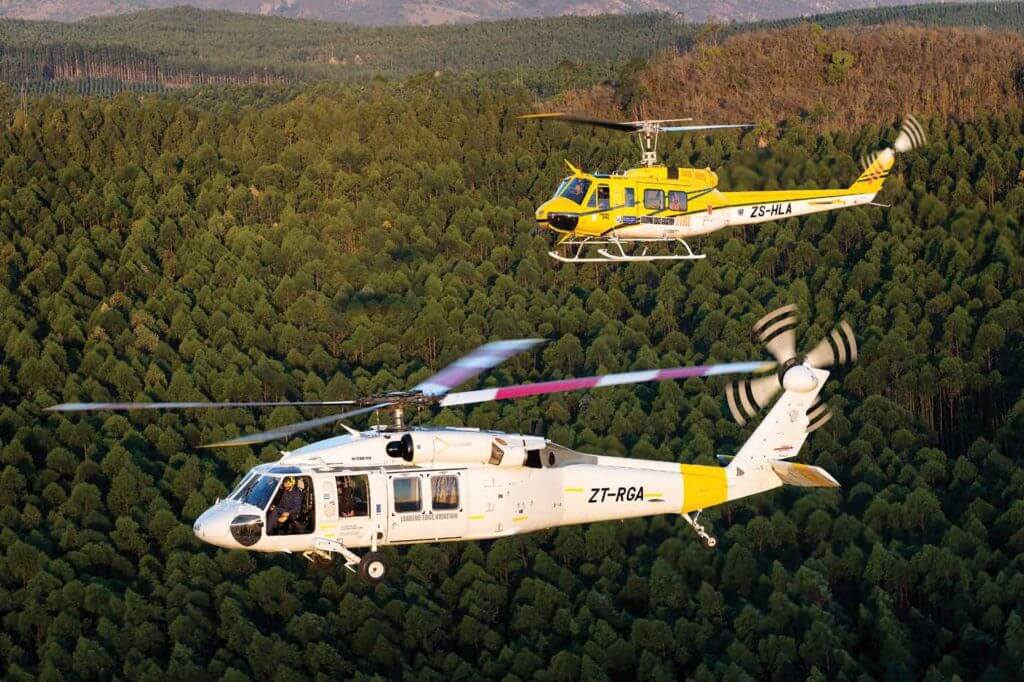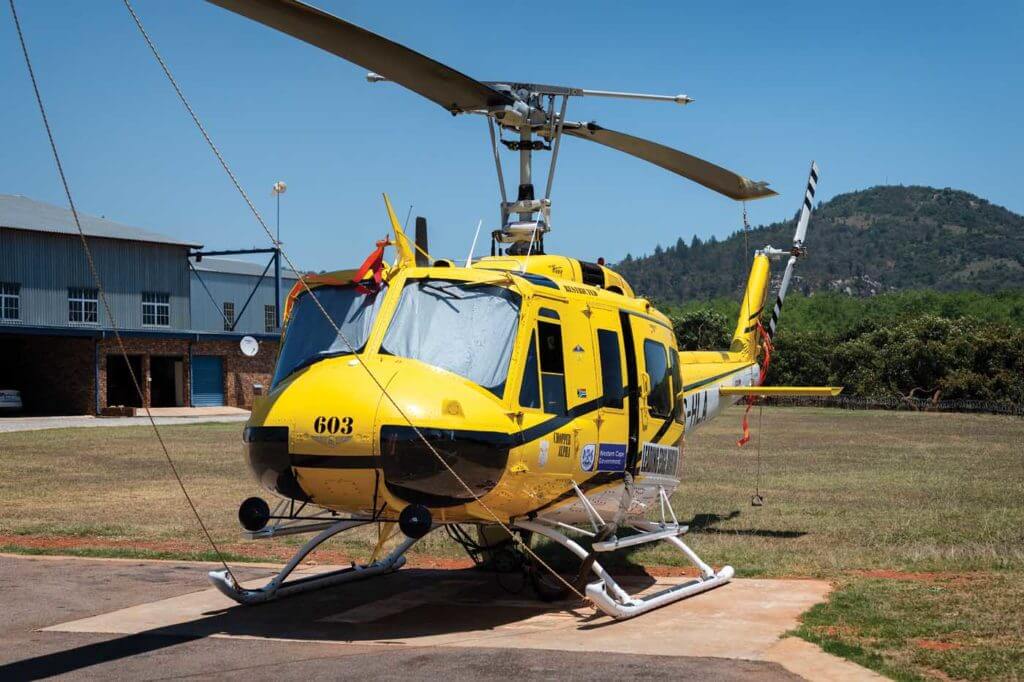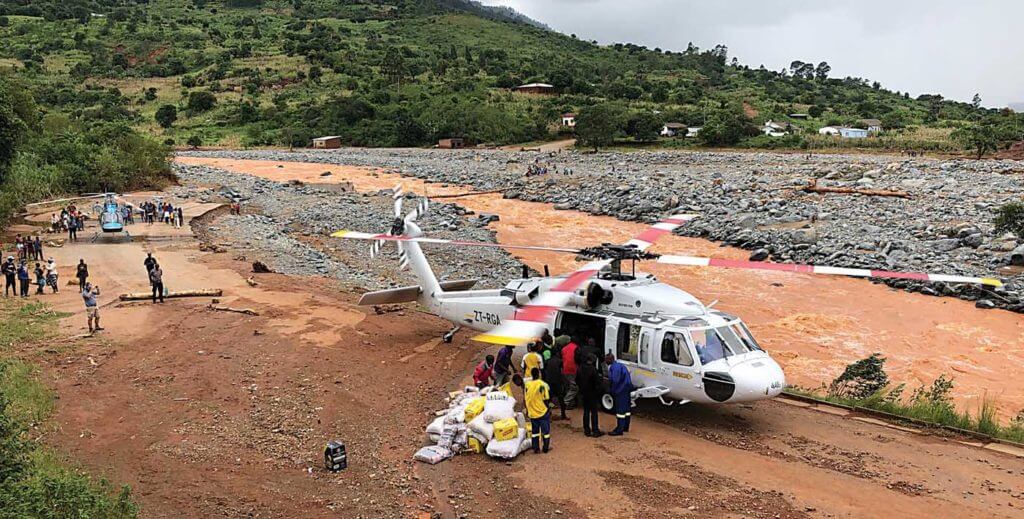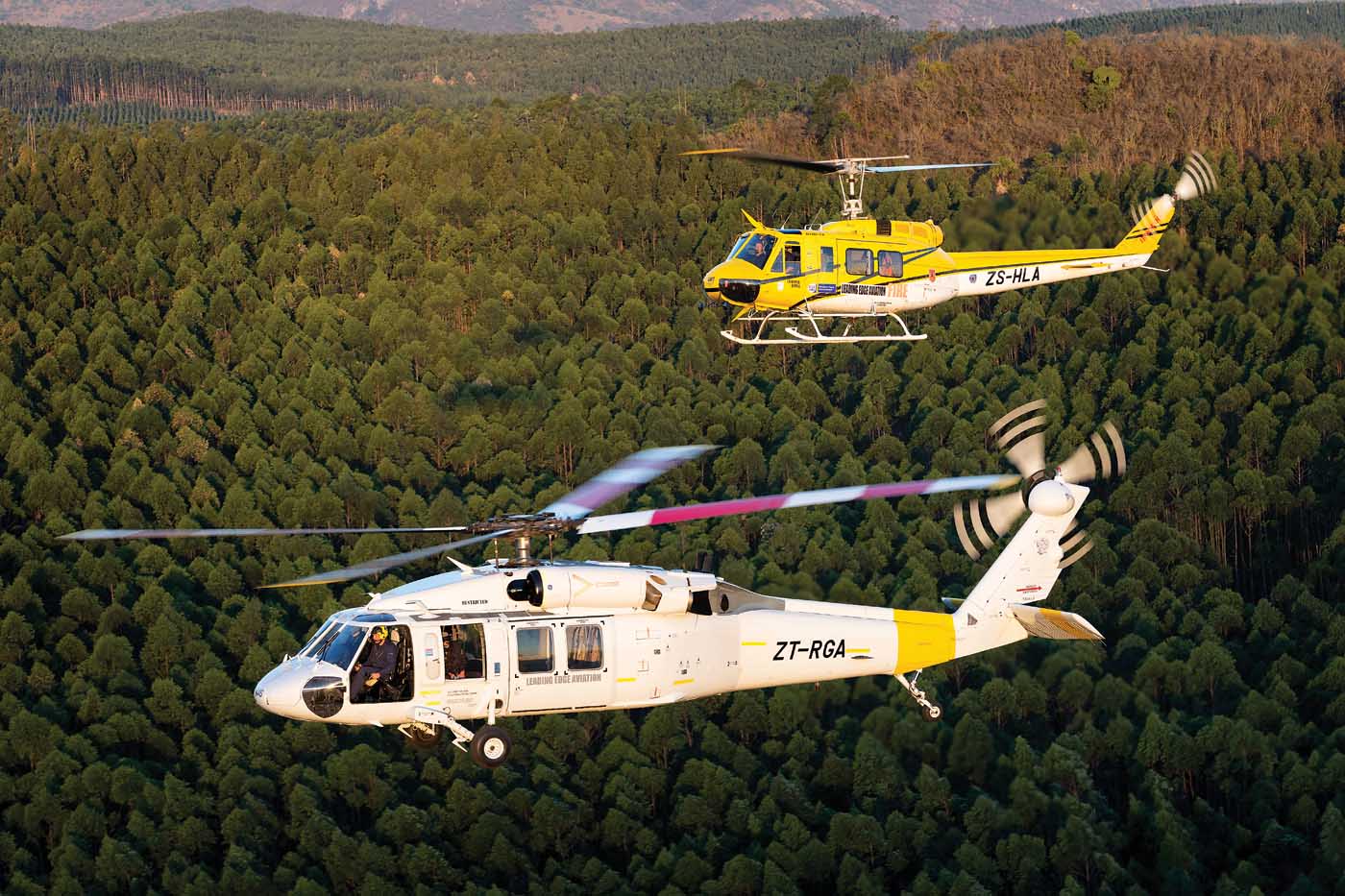Over their four decades in operation, Sikorsky UH-60 Black Hawk helicopters have flown almost every mission you can think of — almost.
Last August, a Black Hawk chalked up what is believed to be a first for the model when it was used to relocate a white rhino in the province of Mpumalanga, South Africa.

Slinging rhinos by helicopter isn’t unusual. And, as more surplus U.S. Army Black Hawk helicopters enter the civilian market, they’re likely to be pressed into service on a greater variety of lift jobs.
For the rhino lift in Mpumalanga, however, the only helicopter up to the task also happened to be the first and only civil Black Hawk in South Africa: a UH-60A owned by Leading Edge Aviation out of Mbombela (formerly known as Nelspruit).
When Leading Edge founder and longtime firefighting pilot Mark Jackson made the decision to acquire a UH-60, he knew it wouldn’t be easy. Not only had there never been a Black Hawk on South Africa’s civil aircraft register, he faced some skepticism about the viability of the larger helicopter in that market.

Now, a year-and-a-half after it first arrived in a South African port, the Black Hawk is starting to prove its worth for firefighting and disaster relief — and, of course, the occasional rhino lift.
“Initially there was a lot of resistance to the Hawk, but as we’ve gone farther down the road, it’s become a great part of the kit at the fire bosses’ disposal,” said Jackson’s son, Peter Jackson, who is one of the pilots and maintenance mechanics on the aircraft.
Describing it as a huge evolution in capability over the Bell UH-1 Hueys that have dominated the business for decades, he said, “I hope it will bring the South African firefighting market forward as a whole.”

Replacing an aging fleet
Mark Jackson’s first exposure to flying came through the Rhodesian Air Force, where he served as a maintenance engineer and crew chief. He trained as a civilian pilot in airplanes and helicopters, and as he progressed through his commercial flying career, “the fact that I could maintain my own aircraft was a massive advantage,” he said.
Jackson and his wife started Leading Edge Aviation in 1996 as an aircraft maintenance facility, also keeping a rotating stable of light airplanes for leasing and other purposes. Meanwhile, Jackson was flying diverse jobs throughout South Africa and beyond.
Some of his most memorable flying was in support of humanitarian aid missions, he recalled. Flying an Aérospatiale Alouette III in support of Air Serv International, he responded to massive floods in Mozambique in 2000. He also flew a Bell 407 for Air Serv after the 2004 Boxing Day Tsunami in Southeast Asia, and supported Médecins Sans Frontières, flying an Airbus AS350 in Pakistan after the 2005 Kashmir earthquake.

Shortly afterwards, Gary Blain of Billings Flying Service in Montana was in the process of acquiring a U.S. Army surplus Bell UH-1H Huey for a friend of Jackson’s when he suggested that Jackson buy one as well. Jackson sold three of his small planes to make the deposit on the Huey, then traveled to the States to seal the deal on the aircraft.
After extensive maintenance and restoration work, the aircraft started its first season of firefighting in late 2006. Beginning in 2007, it was subcontracted to the government-funded fire management agency Working on Fire, with Jackson flying the helicopter under Working on Fire’s operating certificate. He later acquired a second UH-1H.
Over the next decade, the Hueys would fly a combined 3,000 hours on fires, with Jackson flying around 2,200 of those himself. But he began to grow increasingly concerned about reliability and parts availability for the 1960s-era helicopters — and reluctant to see his two sons, both of whom fly, follow him into these legacy airframes. “The Hueys are phenomenal, but it is an aging fleet,” he said.

When Blain suggested that he consider a surplus Sikorsky UH-60A Black Hawk from the U.S. Army’s Black Hawk Exchange and Sales Team (BEST) Program, Jackson was receptive. Not only did the Black Hawk represent a tremendous leap in performance and capability over the Huey, it also featured a fully articulated main rotor, crashworthy build, and redundant systems.
“Your safety margin is hugely increased,” he said. “The fact that I have two sons that have grown up in the industry [meant] the decision wasn’t hard to make.”
As an approved bidder in the BEST Program, Billings Flying Service acquired the aircraft from the Army and obtained a Federal Aviation Administration (FAA) restricted category type certificate for it. Then, Leading Edge began the process of acquiring the aircraft, a complex process that required U.S. State Department approval. “The fact that we had been operating ex-U.S. military aircraft boded well for us,” Jackson noted.

While that process was under way, Peter Jackson and another pilot, Tosh Ross, traveled to Billings Flying Service for flight training in the UH-60A, receiving FAA type ratings that were accepted by the South African Civil Aviation Authority (CAA). The maintenance team of Peter Jackson and Peter Fetting then completed initial maintenance training through Flightsafety International in West Palm Beach, followed by a second maintenance course presented in Mbombela by Billings Flying Service.
Once the aircraft was approved for export, it was inspected by a CAA delegation; shipped by sea to the port of Durban; then underwent another inspection by the Armaments Corporation of South Africa before being reassembled, painted, and granted a CAA restricted category type certificate.
“The fact that it would be the first of its type meant that it would be a massive challenge, especially in a remote place like South Africa,” Mark Jackson said. Peter took the lead in coordinating all of the necessary approvals.

“I’ve been investing a lot of time in the paperwork side of things,” Peter acknowledged when Vertical visited Leading Edge last October. Beyond the critical support from the CAA, he said, Billings Flying Service was instrumental in pushing the process to a successful conclusion.
“We’ve worked so closely with Billings,” he said. “Without their continued input and support, it wouldn’t have come together.”
Selling the value proposition
But getting the aircraft to South Africa was only half the battle. The other half was convincing local industry that it was needed. Observed Ross, “Everything is so tight. Everyone is trying to squeeze the best bang for the buck.”

Ross is an experienced helicopter and fixed-wing pilot who spends much of his time flying Boeing 737 freighters; although he had largely exited the world of aerial firefighting, he was drawn back into it for the chance to fly the Black Hawk. “For me, this was a great opportunity to get involved in something really new,” he said.
As Ross explained, there has been some sticker shock associated with this larger, more capable aircraft, particularly in the firefighting world. However, more people are starting to realize that while the Black Hawk may be twice as expensive as the Huey, it can carry three times as much water — making it a more effective asset in the long run.
“It’s an expensive aircraft if you look at it from an hourly rate. But you have to look at what it can do in an hour,” he said.
The first customer to take a chance on the Black Hawk was Sappi, a pulp and paper company that contracted the aircraft to be on standby for firefighting. Forestry is big business in Mpumalanga province, and Sappi is one of the largest private companies that have found it worthwhile to invest in these types of contracts as an insurance policy for their timber stands during the dry season.

“They really threw us a lifeline by offering us an initial two-month contract,” said Mark Jackson. “Sappi gave us the opportunity to show the aircraft at work.” Sappi was sufficiently impressed to offer Leading Edge additional work through the local fire protection agency for the upcoming fire season.
In February 2019, the Black Hawk was contracted by Working on Fire for the fire season in Western Cape province. A month later, it deployed to eastern Zimbabwe to assist in the response to Idai, an intense tropical cyclone that caused catastrophic flooding there and in Mozambique, Malawi, and Madagascar.
At press time, both the Black Hawk and Leading Edge’s Huey had just returned from moving medicines and supplies to communities cut off by floods and mudslides. The two helicopters delivered 135 tons of lifesaving supplies in just six days — similar to the type of work that Mark Jackson did in Mozambique in 2000.

For Jackson, this type of work is exactly why he wanted to introduce the Black Hawk to Africa’s civil helicopter industry. “I absolutely love helping people,” he said. “I think one of the things you see, particularly with firefighting, you always see the best in people.”
While South Africa can be a challenging place in which to run an aviation business, Jackson said that, given a choice, he would prefer to stay close to home than pursue more lucrative contracts far away. “We would rather earn less and stay in South Africa where we can help our people,” he said.
Looking ahead
Leading Edge began flying the Black Hawk on the operating certificate of Henley Air, a well-known South African helicopter operator, based in Johannesburg, with whom the Jacksons have an established relationship. However, the company recently obtained its own operating certificate, aimed specifically at the firefighting and utility market.

Ultimately, Mark Jackson said he would like to replace his remaining Huey with another Black Hawk. “I’m wanting to usher in a new generation, a new chapter,” he said.
Leading Edge flies its Black Hawk with two pilots and a crewmember in the back, a configuration that is proving helpful in ushering in that new generation. Flying with Ross, Peter Jackson has been able to learn the finer points of aerial firefighting from a more experienced pilot.
“It’s a risky business, but you can mitigate that with the right selection and training,” said Ross. With the Hawk, “we’ve got a great opportunity to train people like Pete, where they can learn things through hands-on experience.”

“The other thing that’s good from a dad’s point of view [is] that you have two sets of eyes watching out for dangers,” added Mark Jackson, remarking on the wire hazards that are particularly prevalent in the Cape region. “What I’m enjoying is that this is a new generation airframe, with the younger generation flying it.”
Leading Edge still has its work cut out for it in learning the finer points of the Black Hawk, and in maintaining it half a world away from the rest of the global fleet. There’s also still work to be done in persuading customers of its value proposition. But everyone involved with the aircraft is optimistic.
“It’s a small team,” said Ross, “but when everyone’s pulling in the same direction and has the energy, there’s nothing you can’t achieve.”
SIDEBAR
Responding to Idai
In mid-March of this year, southeast Africa was hit by Cyclone Idai, an intense tropical cyclone that caused severe flooding in Mozambique, Zimbabwe, Malawi, and Madagascar. At press time, more than 1,000 people were reported to have died as a result of the storm, with thousands more missing and millions impacted by the resulting damage.

Leading Edge Aviation’s Sikorsky UH-60A Black Hawk and Bell UH-1H Huey were on government firefighting contracts in Stellenbosch, South Africa, when the company was contacted by the Zimbabwean telecommunications company Econet Wireless. Econet had partnered with the Bill & Melinda Gates Foundation and Richard Branson, among others, on a humanitarian response to Idai, and was seeking helicopters to deliver much-needed aid to remote communities that had been isolated by mudslides and flooding.
Following intergovernmental negotiations, Leading Edge was released from its firefighting contracts 10 days early. The aircraft and their crews — consisting of three pilots, one mechanic, and one crew chief for the Black Hawk, and two pilots and one crew chief for the Huey — departed directly for Mutare, a city in Zimbabwe’s eastern highlands, where a staging area had been set up for relief operations. There, they joined four other civilian helicopters (two Bell 407s, and two Airbus AS350s) as well as two Agusta Bell 412s and an Airbus Alouette III from the Air Force of Zimbabwe.
A central command post in Mutare was staffed with representatives from the Air Force and participating nongovernmental organizations, who allocated aircraft to specific missions. According to Leading Edge’s Peter Jackson, the load-carrying abilities of the Black Hawk and Huey made them preferred for moving supplies, while the smaller helicopters were used to transport doctors and other aid workers.

Many of the affected mountain communities had no landing areas suitable for the Black Hawk, so it flew most of its cargo in one of three nets at the end of a 170-foot long line. Jackson said the crews quickly found an efficient rhythm: “We would take a full net out, and by the time we came back we would drop that first one off, pick up the next full load and then take off again. So we were able to really leapfrog on that and that kept our RPMs up all the time. One day we did nine hours in a day between the three [Black Hawk] pilots, with only one start and one shutdown.”
The Black Hawk also performed one medevac mission involving two babies who had been critically injured in a building collapse. Along with their mothers and an attending doctor, they were flown to Mutare for transfer to a local hospital.
Jackson described the operations in Zimbabwe as “incredibly rewarding” and “what helicopters were made for.” Pioneering helicopter designer Igor Sikorsky, who always emphasized the lifesaving potential of his machines, doubtlessly would have agreed.






I worked with Mark in 2000 and used his services many times. A finer humanitarian you would be hard pressed to find.
Bob Strother former Airserv member in Mozambique.
Fantastic article